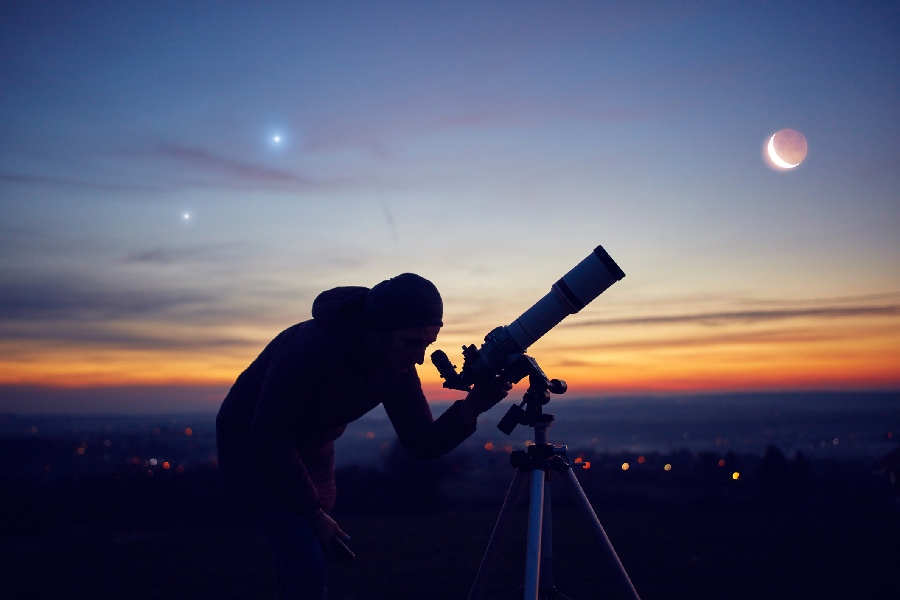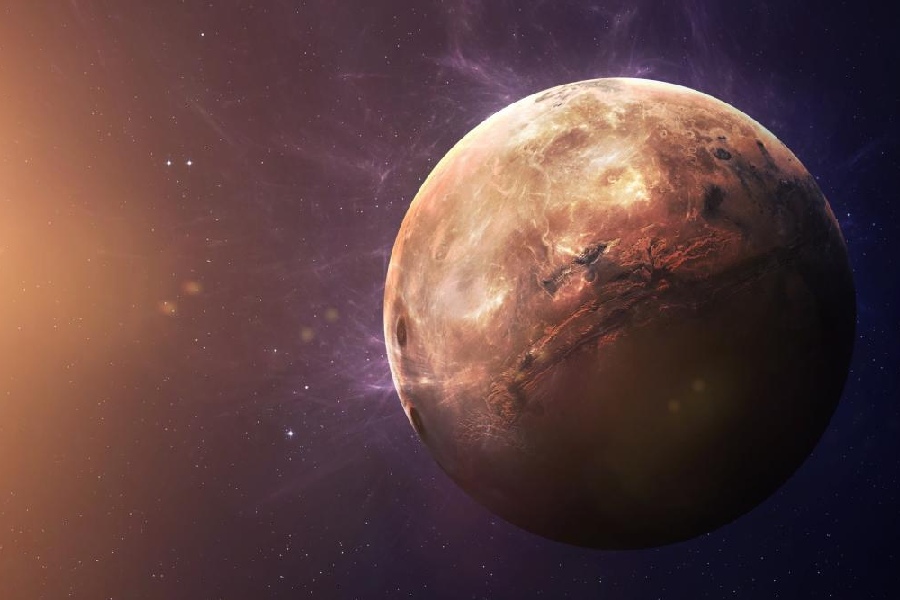Mercury is the smallest and innermost planet in our Solar System. With its proximity to the Sun, sightings of this elusive world have challenged skywatchers for centuries. So, can you see Mercury without a telescope?
Some people claim to have seen Mercury with the naked eye. However, the extreme and precise conditions required make such sightings questionable.
In this article, we’ll investigate techniques used by those who say they’ve succeeded in spotting Mercury with the naked eye. We’ll also dig into the physics that explains why Mercury is easier to find at some apparitions than others.
Can You See Mercury Without a Telescope?
Mercury is visible to the naked eye, and you can see it without a telescope. However, spotting Mercury is challenging because it is usually close to the Sun in the sky.
It’s best observed during its greatest elongation, which is when it appears farthest from the Sun. Depending on its position in orbit, individuals can look for it low on the eastern or western horizon just before sunrise or after sunset.

Mercury’s Orbit and Visibility
Mercury, the closest planet to the Sun, follows an oval-shaped orbit. Due to gravity, it completes an orbit around the Sun every 88 days. So, can you spot Mercury from Earth without using a telescope?
As Mercury orbits, its distance from the Sun varies, impacting its brightness. When farthest from the Sun, Mercury appears brighter. This is due to its greater apparent brightness during that phase. Additionally, Mercury’s orbit is tilted compared to Earth’s, leading to variations in its apparent height above the horizon.
A higher angle makes Mercury more visible as it clears obstacles near the horizon. The angular separation between Mercury and the Sun’s glare also matters. Greater separation lets observers see Mercury better at sunrise or sunset, as the planet emerges distinctly from the Sun’s harsh light.
Mercury’s visibility changes through the year. It appears highest at sunrise or sunset in autumn and spring. This is when its angular distance from the Sun is greatest. Summer and winter have poorer visibility due to less separation.
Best Times to Spot Mercury
Optimal times and phases for Mercury visibility
Elongation is when Mercury appears farthest from the Sun. The greatest elongation happens when Mercury reaches its maximum angle from the Sun. These times provide good visibility. It happens around every three to four months.
Mercury’s visibility windows last weeks when appearing as “morning star” or “evening star“. These apparitions happen around the greatest eastern or western elongations – when Mercury maximizes separation from the Sun’s glare.
Like the Moon, Mercury’s phases change its illumination. The full phase gives more light but less elongation. The half-lit phase near peak elongations strikes a balance – moderate lighting yet the angular distance to spot Mercury next to sunrise or sunset skies.
Naked-Eye Observation Techniques
Importance of dark skies and low horizon
Dark skies help reduce light pollution, making faint objects like Mercury more visible. To see Mercury clearly, it’s important to have an unobstructed view near the horizon. Light pollution can hide Mercury completely, so finding a location away from city lights is crucial for success.
For the best results, head to remote countryside areas with no nearby towns. Even in dark sites, it’s essential to have a clear view near the horizon. Trees, buildings, and hills can block the view of Mercury low in the sky. It’s ideal to scout observation spots ahead of time, looking for wide-open sightlines with no obstructions just above the horizon.
Choosing sites with good horizons in the directions of sunset or sunrise increases the chances of seeing Mercury’s elusive disk emerge in the twilight right after dusk or just before dawn. With adequate preparation and planning, individuals can position themselves perfectly to attempt to spot swift Mercury during its brief moments of visibility.
Spotting and distinguishing Mercury in the night sky
Due to its planetary nature, Mercury presents itself as a luminous, star-like dot devoid of the typical twinkling associated with stars. Unlike many stars, its color resembles white or bluish-white rather than the common yellowish or reddish tones. One should direct their gaze towards reference stars to pinpoint Mercury in the sky.
Its faint magnitude is a distinguishing feature, setting it apart from brighter celestial objects such as Venus. Mercury outshines all stars despite being a planet and maintains a steady luminosity.
The absence of twinkling further distinguishes it from its stellar counterparts. Over weeks, its gradual movement against the background of stars confirms its identity, differentiating it from faster-moving satellites or meteors.
Detecting Mercury near sunrise or sunset remains a challenging task, even with the aid of optical instruments. However, patient observation with the naked eye during optimal apparitions can unveil the elusive Mercury to the keen observer.

Historical and Cultural Significance
Ancient astronomers knew of Mercury. But its proximity to the Sun made details difficult to discern. Galileo first observed Mercury’s phases in 1631 using an early telescope.
In the 1800s, there were cases where astronomers believed they had discovered moons orbiting Mercury. Still, they had seen other objects temporarily passing in front of Mercury (transiting) rather than being true satellites. However, improved telescopes finally confirmed no such moons existed.
Furthermore, Ancient Greeks associated Mercury with their messenger god Hermes. Chinese astrology links the planet to the element of water, intuition, and communication. In Hinduism, Mercury represents intelligence and education.
In astrology, Mercury governs thinking and communication. People born when Mercury appeared in the night sky were thought to be influenced by its properties. Mercury’s elusiveness led ancient skywatchers to attach divine stories to its fleeting appearances and removals from view.
Challenges and Tips for Observing Mercury
Mercury can be tough to spot in places with many lights or things blocking the view. The bright lights make it hard to see Mercury, which is small and low in the sky. Going out to darker areas away from cities gives you a better shot, but in many cities, Mercury disappears early.
If the sky is covered in clouds, one won’t see Mercury at all. Even if it’s just hazy or humid, it can make Mercury hard to see. The best conditions are when the sky is clear and crisp. To see Mercury without a telescope, individuals need good techniques.
Try looking for Mercury when it’s at its farthest point from the Sun, either just before sunrise or just after sunset. Use tools like binoculars to find it, but then try spotting it with the eyes once individuals know where to look. Keep trying during the best times, and one might finally catch a glimpse of the elusive Mercury without any equipment.
Photography and Technological Aids
Capturing clear images of Mercury without telescopes poses a challenge, but it’s achievable. The key lies in having the right equipment and settings to expose the small planet adequately. While smartphone cameras can provide acceptable images, dedicated cameras offer superior resolution.
When capturing faint images of Mercury, the stability provided by tripods becomes crucial for achieving long exposure shots, especially in low-light conditions. Apps like SkyView are handy tools, precisely guiding observers by pinpointing Mercury’s location, visibility windows, motion against background stars, and elongation dates.
Furthermore, the camera settings play a crucial role in the process. Manual mode allows for customizing optimal shutter speed, ISO, and aperture. Utilizing long shutter speeds, lasting several seconds or more, proves effective in capturing Mercury’s subtle light. However, it’s essential to be mindful of high ISO settings, which enhance sensor sensitivity but can also introduce unwanted image noise.
Post-processing steps can further enhance the captured images. Stacking multiple short exposures of the same scene reduces noise in the final picture. Additionally, careful adjustments to contrast and brightness can help highlight Mercury’s small disk against the backdrop of the sky.
Conclusion
Can you see Mercury without a telescope? As discussed, yes, one can see Mercury without a telescope. We explored everything from Mercury’s elusive properties to optimal sighting conditions and photographic capture tricks.
A telescope ensures seeing Mercury, but many still find its natural view captivating, motivating seasoned observers to refine their skills. Understanding the cosmic choreography allows for brief glimpses of this inner planet without any equipment.
Timing plays a crucial role in spotting Mercury without assistance, requiring precise planning, endless patience, and a bit of luck for the perfect alignment. Achieving this feat blends careful preparation and perhaps a stroke of fortune. So, enjoy the thrill of spotting speedy Mercury successfully, whether with a telescope or without one.
